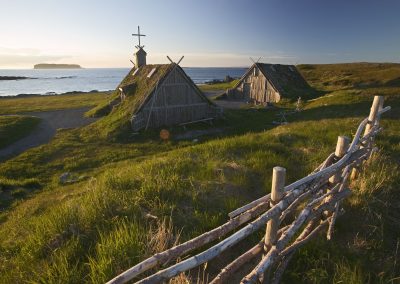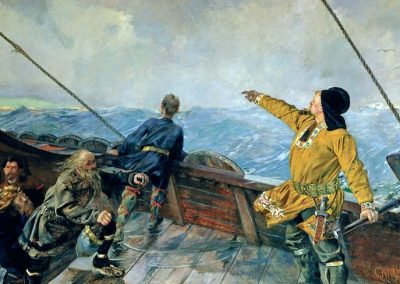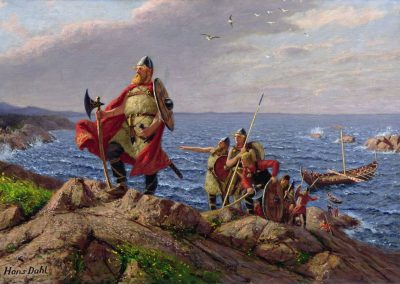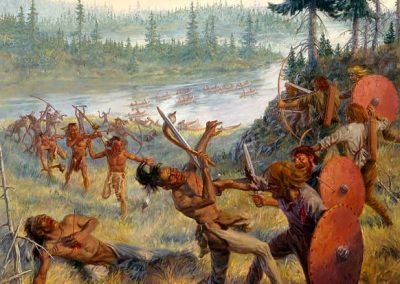The catholic faith of the Vikings in Canada
The Vikings chose the Catholic religion in the 900s, partly because of the extensive trade networks with the Christian regions of Europe, but mainly because of the increasing political and religious pressure of the German empire in the south. By the end of the Viking period, around 1050, most Vikings were Christians. However, we know that the Vikings went to Canada around the year 1000. Some remains show that many of them were already Catholics. Indeed, the remains of a Viking Catholic chapel were found in Labrador. Some even say that Viking crosses were found there. It was thus, it seems, the first presence of the Catholic faith in Canada.
“It is, without a doubt, Harald with the Beautiful Hair which was, involuntarily, the cause of the discovery of America by the Vikings. This prince, who took power in 860, wanted to unify the kingdom of Norway. Many of his compatriots opposed his action and preferred to leave their country rather than to undergo the authority of Harald. Thus, within a few years, Iceland received as many proud Viking peasants as it could feed. Around 930, it is estimated that the population numbered between 16,000 and 20,000 and exceeded 30,000 at the end of the tenth century.
The most famous of these emigrants was undoubtedly Erik the Red, son of Thorwald Asvaldsson. After the death of his father and his marriage to the daughter of a prominent Icelandic family, he settled in Haukadal and from then on had violent quarrels with his neighbors. As a result of one of them, two of his opponents were found dead where he had had a stormy argument with them. Erik the Red, badly defended before the Thing (a kind of Icelandic parliament with judicial powers) was condemned, with his own people, to three years of banishment.
Instead of taking the direction of old Europe, Erik the Red moved towards the west, then turning south, skirted the eastern coasts of Greenland, doubled Cape Farewell and reached the area of the fjords. This voyage took place in 982 […].
It was Erik the Red who gave Goenland the name it bears to this day: the Green Country. Our hero himself admits that he chose this name in order to attract as many Normans as possible, because he thought that many people would want to go there if it had a pretty name.
After his three proscription loves passed, Erik the Red returned to Iceland. There, he announced that he had found two places in Greenland that were perfectly suitable for settlements; he himself had christened them: Oesterbygden, which means eastern colony, and Vesterbygden, which means western colony.
From that moment on, we see Erik the Red, this colerous, tough Icelander, using all the energy of his temperament to organize the Norman colony of Greenland, of which he was the undisputed leader, if not the king.
In the spring of the year 986, Erik the Red was able to set sail for Greenland with 25 ships, with 500 to 700 people on board: men, women and children. He also carried horses, tools, livestock and cooking utensils. The expedition was a very adventurous and risky undertaking; a violent storm brought a toll of 11 ships to the ocean, so that only 14 reached the Greenland […].
Life in Greenland was rather hard for the Vikings; they lacked three essential elements: wheat, wood and iron. Regular exchanges and trips to Norway and Iceland helped to alleviate these disadvantages. On the other hand, the region was rich in whales, fish, seals, different kinds of birds; there were also hares, bears, reindeer and also, unfortunately, wolves.
Erik the Red’s fleet had just left Iceland, when a young man named Bjarn Herjulfson arrived on this island to meet his father. He was astonished to learn that his father had joined Red Erik’s expedition and was sailing towards the Green Country. Bjarn did not hesitate for a moment and decided to join his father and set sail west, without even unloading his cargo.
It was during this wildly daring journey that Bjarn, after 3 days of sailing, was caught by the fog and started drifting aimlessly. Then the north winds picked him up again, but for several days he was unable to determine his position.
Finally, one day he saw a wooded and slightly hilly land; Bjarn was not mistaken: it was not Greenland. The encounter with this land did not arouse his curiosity, because his only goal was to join his father Herjulf in Greenland. For us, this is very important, because Bjarn Herjulfson, had just discovered America.
In fact, he had sighted the Labrador coast at a point southwest of Cape Farewell. He sailed north again for 5 days and saw the land two more times without recognizing Greenland. Finally, the wind rose, which allowed Bjarn to reach a point on the coast where several ships were being towed on the beach. There lived Herjulf, father of Bjarn, and it was Greenland.
During his difficult journey Bjarn had seen a new land as he passed by. Leif Erikson, son of Erik the Red, was given the task to explore this land. To do so, he acquired the Bjarn ship. Following exactly the indications given by Bjarn, Leif Erikson, with a crew of 35 men, set sail north along the west coast of Greenland and then south along the Labrador coast, which was an excellent way to make sure that nothing was overlooked in his exploration.
He first approached a rocky and icy region, which he named Helluland, which means: rock flat; it should be noted that the English later called it: Table Land, which has exactly the same meaning. The second land that Leif Erikson found was wooded and bordered by white sand; he called it Markland, which means: land of forests; it is located on the coast of Labrador. Finally, further south, he reached a third region which he named Vinland, because wild vines grew there.
It was a German, companion of Leif Erikson who found this vine one day when he had moved a little too far from the Viking camp. This German, born in the land of wine, used the grapes in the same way as later immigrants in the 17th century. He pressed the grapes in his hands, left the liquid to rest for 5 or 6 days and when the drink was ready he felt the effects. The saga of Greenland reports that Tyrkir, that was the name of our German, regained, thanks to wine, the use of his mother tongue… It is a well-known phenomenon.
Leif and his men decided to spend the winter in Vinland. They built big houses and Leif gave his name to this colony which became Leifbudir. It is probably this settlement, which in 1002 or 1003, Leif’s brother Thorwald frequented; then later, in 1006; Thorstein, the third son of Erik the Red; and finally, the Irishman Thorfin Karlsefni, whose son Snorri is said to have been born in Vinland […].
What was the end of the brave little Viking colony? Everything suggests that it was decimated by the Skraelingars, probably Eskimos living in the Vinland region.
The saga of Greenland also reports a number of fights, which have been recounted by the survivors of Leifbudir. During one of them, Freydis, daughter of Erik the Red, seeing the Vikings bending, assaulted by a large troop of Skraelingars, grabbed the sword of a Norman who had just been killed, tore the top of his dress and bare chest, attacked the adversaries, who, frightened by this New World Walkyrie, fled in disorder. Another interesting episode is the contact that took place for the first time between the Stone Age and the Iron Age.
Here is how the saga tells it: the Skraelingars found a dead Viking; next to him was his axe; they took it and one after the other stuck it into a tree trunk.
The sharp axe looked like a precious object to them, but as one of them tried to split a stone, the axe shattered. They threw it away, probably thinking it was useless to keep a tool that could not even resist a stone.
According to the old chronicle, the surviving Vikings withdrew to Greenland and took two skraelingars with them and had them baptized. It is thanks to these children and their language that we now know that the Skraelingars were Eskimos and not Indians.
Sources :
Bulletin de la Société d’Histoire de la Guadeloupe, Les Vikings au Vinland, Yves Reignard, Numéro 7, 1er semestre 1967





